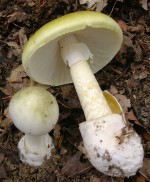 The Death Cap is found singly or in troops growing in rich soil throughout the temperate zone of the Northern Hemisphere from late summer to fall. It is mycorrhizal with a variety of hardwoods such as oak, beech, and hazel., and conifers including pine and Norway spruce. The mushroom stands two to six inches tall and has a cap four to seven inches across. The greenish fleshy cap is egg-shaped and completely enclosed in a veil when it emerges from the soil but becomes convex to flattened as it matures. The smooth surface of the cap is fringed with radiating fibrils and may be greenish to yellow or white. It is shiny in dry weather and somewhat sticky in damp. The margin is inrolled at first but becomes sinuous with maturity. The white gills are free, uneven, soft, and relatively crowded. The slender stem arises from a large base (volva) and is white with fine scales the color of the cap. A white striated ring, the remains of the annulus, hangs from its upper region. The spores are white.
The Death Cap is found singly or in troops growing in rich soil throughout the temperate zone of the Northern Hemisphere from late summer to fall. It is mycorrhizal with a variety of hardwoods such as oak, beech, and hazel., and conifers including pine and Norway spruce. The mushroom stands two to six inches tall and has a cap four to seven inches across. The greenish fleshy cap is egg-shaped and completely enclosed in a veil when it emerges from the soil but becomes convex to flattened as it matures. The smooth surface of the cap is fringed with radiating fibrils and may be greenish to yellow or white. It is shiny in dry weather and somewhat sticky in damp. The margin is inrolled at first but becomes sinuous with maturity. The white gills are free, uneven, soft, and relatively crowded. The slender stem arises from a large base (volva) and is white with fine scales the color of the cap. A white striated ring, the remains of the annulus, hangs from its upper region. The spores are white.
As the common name implies, this mushroom is deadly poisonous.. It is attractive, resembles some edible fungi, and has a pleasant, rose-honey fragrance when young. A single specimen, however, can cause death and the mushroom is responsible for ninety percent of the fatal mushroom poisonings. The first symptoms are stomach upset with diarrhea, nausea, and vomiting so that dehydration threatens that can lead to death. Irreparable liver and kidney damage follows. The sooner the treatment begins the better chance for survival. Although there is no antidote for the poison, doctors minimize the damage to kidney and liver and save the life of the victim even though kidney dialysis, and/or liver and kidney transplants may be necessary.
The deadly effects of the Death Cap have been noted since ancient Roman times when Emperor Claudius’ death was associated with the fungus. Likewise, the death of the Holy Roman Emperor Charles VI, may have been caused by the Death Cap as he suffered symptoms consistent with Death Cap poisoning after eating a dish of sautéed mushrooms. Other notables may have suffered similar poisoning but evidence is lacking.
Photo Credit: Archenzo, Wikimedia Commons